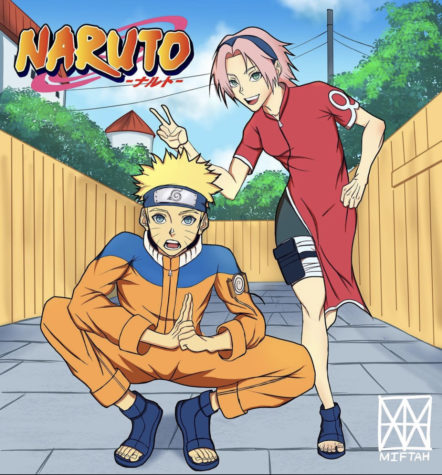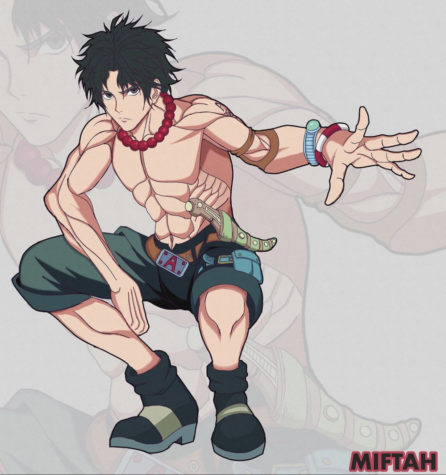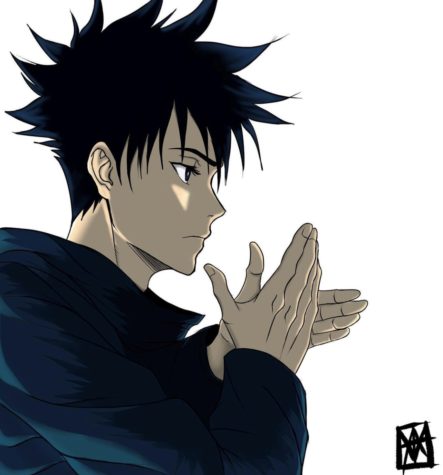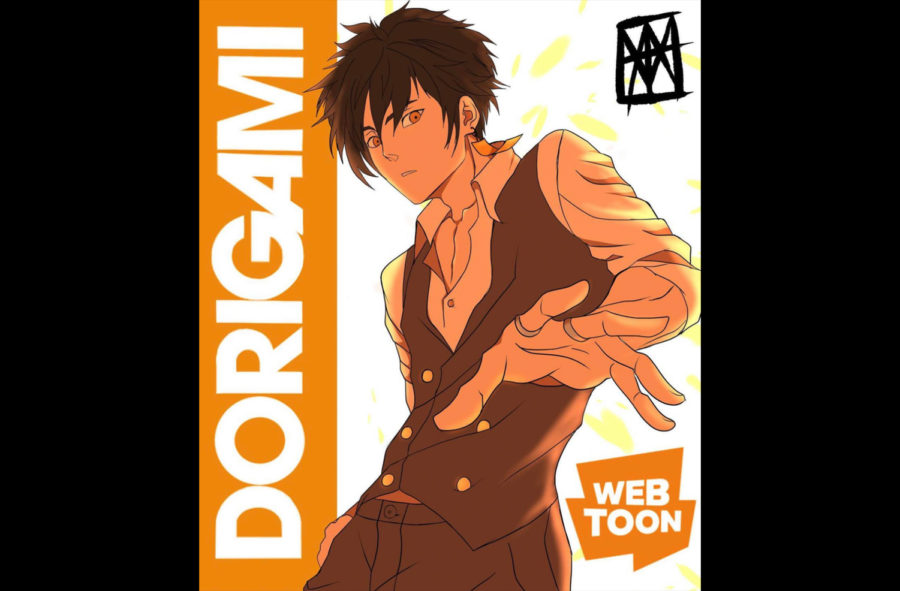A Profile of the Future Manga Artist Marzuq Miftah ’22
A profile of the recent Bronx Science graduate Marzuq Miftah’s struggles between pursuing practicality and his dream of being recognized as one of the great manga artists of his time.
Here is a drawing of one of the characters from Marzuq Miftah’s upcoming comic ‘Dorigami’ which will be entered into a webtoon contest. It features his artist signature on the top right, with lines which if arranged in certain ways spell out his name.
The first time I met Marzuq Miftah ’22 was in my ninth grade English class at Bronx Science. It was during fourth period, after a drowsy geometry class, a tiring Spanish class, and a relatively energetic global history class. What makes the first day of school important is that you are randomly selecting people to sit next to who will probably be your friends for at least a couple of months. For me, what was supposed to be a few months became four good years with someone who, after all this time, I still don’t know completely.
There were some key things I noticed about Marzuq Miftah that made him stand out from anyone else. For one, it was very rare for him to ever do any work outside of school. Everything and anything from major assessments to miscellaneous math worksheets was completed before he got home.
There was no passion in his work; all he wanted was the bare minimum good grade for the assignment. When it came to tests, he naturally scored well with little effort put into studying outside of class.
It was baffling to me — at the time I was procrastinating as much as I could, and I could not understand how one could so effortlessly commit themselves to their work. The real mystery was why he did it. I often wondered, what urgent thing did he have to do that he had to make sure absolutely everything was done before he came home?
I really only got that answer this year, but looking back at all our time together, the answer was preparing a slow reveal of itself through various subtle hints. Most obvious of them all was the dedication he put into certain types of projects.
All of the sophomore level English classes were reading a rotating list of books, one of which was Geoffrey Chaucer’s The Canterbury Tales. For one of their assignments, Marzuq’s English class was tasked with creating depictions of the characters in the story.
I learned of this assignment when I met up with Marzuq on a winter morning before class, and he enthusiastically pulled out some of the drawings he made to show me. I must have asked him if he drew them ten or so times before I truly believed he did. The illustrations faithfully followed Chaucer’s descriptions of this complicated cast of characters held together by a pilgrimage, yet there was also a presence of his burgeoning art style in the work. The effort into style was peculiar, and there was nothing like it in any other thing I saw him work on.
He told me that when it came to projects that involved art, he would always make sure to put in substantially more effort than he would in regular assignments. For this project, he found the process of actualizing his understanding of the characters into a visual form particularly fulfilling. “The great thing about art is that it allows you to see how different people form different interpretations about ideas and the ways in which they choose to represent them,” he said.
Miftah’s strongest influences in terms of his art find their origins in the Japanese mediums of anime and manga — the Eastern equivalent of cartoons and comics. His introduction to these forms was prompted by an older cousin at the age of four. “My brain comprehends manga and anime better than the western stuff because it was what I grew up on,” Miftah said.
This was an era where you would turn on the television to watch twelve-year-olds fight each other with monsters stored in pocket sized balls or extraterrestrial beings with blonde hair and monkey tails protecting the world from otherworldly threats.
Though many of these works were instrumental in sparking the passion that Marzuq has for his own art, there are a couple authors, stories, and characters that stand out. He cites Masahsi Kishimoto, the creator of Naruto, Naruto Shippuden, and Boruto as one of the first to pique his interest.

Kishimoto’s stories generally revolve around themes of outcasts and underdogs growing strong enough to be acknowledged by those that doubted them. His most famous work and the one Marzuq initially resonated with follows the titular character Naruto with the goal of being the strongest in a world of ninjas with supernatural powers.
For me as a kid, Naruto’s likeability as a protagonist came from the exhibition of his iron will against crushing odds and an overwhelming sense of discouragement. This is one of the tropes that belongs to one of five demographics of manga known as shonen, which focuses on catering towards the hearts/interests of young boys.
The other demographics include shojo for young girls, seinen for adult men, josei for adult women, and kodomomuke for very young children. Although there are a vast amount of genres and themes in each demographic, there is usually some overlap in the ways that these stories are written and illustrated.
Naruto is the model that many new and aspiring artists follow which is why many of the works published in Weekly Shonen Jump — the most popular magazine for shonen manga — follow its formula and structure. This creates works that are often repetitive or contrived.
However, these stories often find ways to rewrite the formula, bringing originality into the genre and generally the tropes of shonen manga are admirable regardless. Ideals like working hard to achieve your dreams, doing what your heart desires despite the obstacles, and the power of good friends attract both the intended audience of the medium as well as those far from the demographic.
While Marzuq admires all of these things concerning shonen manga, he still wants to innovate in his own right. He told me, “Manga artists have a saying that there are only five unique stories, that everything else is some derivation of them. I want to make something that takes the place of the sixth story.”
Another important influence that speaks to this aspiration is Eiichiro Oda, creator of One Piece — a series that has been releasing chapters since 1997 with over 490 million copies sold worldwide and claiming the title of best-selling manga in history. The series follows a teenager’s quest to become king of the pirates and find the legendary One Piece left behind by the previous pirate king as a means to choose his successor.
For Marzuq, Oda’s work displays the ultimate peak in development of characters, stories, relationships, and world building. As a series that has been running for more than twenty years, One Piece still enthralls its fan base through mysteries that have been left to fester for decades and a world that is ever-expanding. Following Oda, Marzuq wishes to create a world that is “living, breathing and leaves the same kind of impact.” Combining all of these aspects, he hopes that he can innovate in a way such that others see his work as a model for their own.
After consuming this media with the abundance of free time that children tend to have, Marzuq would begin trying to sketch the characters from references he would locate on the internet. “I would draw a lot in class because I was usually unable to see the board and I didn’t get my glasses until a year ago so all I could focus on was the sheet of paper and pencil in front of me,” Miftah said.
Though he would spend much of his youth practicing his skills, he would not get serious about pursuing his art until the death of his grandfather. Their relationship was very close.
After his death, Marzuq was able to look through his grandfather’s old writings and poetry. He discovered one that read, “The black sheep wants to be accepted but will always be neglected. Time flies by, the sheep has lost his opportunity to be true to who he was. The sheep could have spent his years living a life he was proud of other than a life that was a lie. But if the sheep passes his dream to another, he could be happy forever.”
This was the moment where Marzuq felt that if he did anything in his life, he had to carry out the wishes of his late grandfather by following his ambitions as best as he can so as to live his life to the fullest. With this, Marzuq began taking steps towards making his dreams a concrete reality.

If one wants to put oneself out there, to cultivate a career or brand, it becomes necessary to network and maintain a social media presence. Marzuq’s art account on Instagram (@art0fmiftah) initially began as a way to showcase progress and quick sketches for practice but very soon grew into something greater.
Looking through it, there’s an incredibly stark contrast between the early Marzuq and the late Marzuq. It is like flipping through old photo books, but in a much more condensed form. You can see what he was struggling with and when he decided to switch things up — whether that is a change in his equipment or experimentation in his style. In particular, there’s a contrast in the roughness of his early digital art attempts and his most recent works. “There was a period where I was drawing just to get myself grounded but I wasn’t trying to improve at all. Then towards the end of last year I started properly studying different techniques because I realized that if I wanted to make this a career I would have to really put in the work,” Miftah said.
While talented, he still faces outside struggles that prevent him from practicing to the extent that he wants to. “I struggle with constant migraines; they happen at least once a week, and when I have the time to practice on weekends, they always seem to flare up. I know that I have to be consistent if I want to grow my social media presence and get better in general, but my migraines make it hard for me to make progress,” Miftah said.
During this time, he found himself affiliated with a group of artists who were all starting out just like he was. “It was an environment where everyone was new but they all really wanted to get better and that atmosphere was inspiring. I got close to some of them, we would go live on social media and do artist collaborations together. It was a process of my friends having connections and those connections having connections and my network expanding that way,” Miftah said.
Though I followed the art account for a while, it was not until I returned to senior year in-person that I discovered the extent of the networking that he had done. I remember I was sitting in the library during our shared third period free and he sprung it on me that he had multiple job offers from American manga and webcomic publishing companies. For one of them, he was directly recommended by one of his contacts in the artist community. For the other, he used to contribute fan art to the company’s publications and he was contacted for a job after they kept receiving his work. Marzuq always had this tendency to hide these big milestones and achievements and then tell you about them, catching you off guard.
There was one time where he randomly revealed he was admitted to Northeastern University early while we were all awaiting regular decisions. He then explained that he rejected the offer even when a Bronx Science alumnus asked him to reconsider, which was particularly difficult to hear considering that we were all suffering from a slew of rejections.
This was one of the only universities where he applied as an art major but chose to turn it down for a full ride at St. John’s University majoring in biology on a pre-med track. The choice to decline art for biology is partially motivated by the stereotypical expectations of immigrant parents.
The language of creativity was mostly alien to immigrant parents who viewed their children’s lives as investments into the future of the family. Behind this idea, there was always a human concern for how one would end up if they did not go into one of the lucrative fields like medicine or engineering, but the way in which it was enforced was stifling.
You are locked in and pressured to do something that you may or may not want to do; there is no place for anything short of commanding respect and bringing success. Art in their eyes does not belong in that category of careers you are allowed to have.
“I can’t even talk to my parents about it. Whenever they come into my room and see the sheets of paper I have scattered around with my drawings they pick it up and tuck it away. It’s like that part of me doesn’t exist to them,” Miftah said.
So, in light of that obstacle he decided to pursue biology as a way to appease his parents and to have a backup. He chose St. John’s University because he had heard that the workload was relatively lighter.

A big problem with trying to pursue art is that it requires a huge time commitment that was just not available to him while he attended Bronx Science. Even though he finished his work as quickly as possible, the workload from school and the commute did not afford him the energy to work on his passions.
His plans are to take advantage of the breaks and more flexible schedule of college in order to devote time towards his art career. Currently, he has committed to working for one of the two publishing firms he got offers at as a line artist. From what he told me, the pay was extremely good for a student fresh out of high school but we could not discuss the specifics.
Though there is a path for him to start publishing his own works through the company, what he wants to do most is self-publish. “The most successful comics are the ones that are self-published from what I’ve seen and generally I would just like to have my work created on my own terms,” Miftah said.
What he really believes will skyrocket him to success are some of the prolific comic contests, such as the official Webtoon Call to Action Contest and the Jump Tezuka Manga Contest. At the moment, he is preparing for the Webtoon contest as the submission date approaches in approximately two months.
For the contest, he plans to create a chapter-long work of his own original comic for a chance to win monetary prizes and a deal with the firm to continue publishing the comic. What he is working on right now is entitled ‘Dorigami,’ for which he has released a couple bits of promotional art but has not revealed much more.
Although he has a story in mind, the nature of the competition might cause him to mold it towards what the previous winners of the contest have done. However, Marzuq does not lament having to give into formula, he sees this as a first step towards being able to have the freedom and security to truly innovate the shonen genre.
He plans to build up his network and notoriety as an artist before he finally starts creating something that he may someday consider his magnum opus. Marzuq is particularly interested in introducing characters and stories from his own background that are not portrayed in an art form heavily dominated by its Japanese influence.
“There are very few people who look like me that are in manga or are doing it as a career. Think of watching a movie or a television show where you see someone who looks like you, and you feel a sense of joy, because you can relate to what they’re struggling with. I want to create a story full of diverse characters that everyone can relate to and become prolific enough that I stand out as a South Asian person in an East Asian form of storytelling,” Miftah said.
With summer vacation in full swing, Marzuq feels ready to devote all of his free time to developing his story for the upcoming contest and continue along the lines of his grandfather’s wishes.
“There are very few people who look like me that are in manga or are doing it as a career. Think of watching a movie or a television show where you see someone who looks like you, and you feel a sense of joy, because you can relate to what they’re struggling with. I want to create a story full of diverse characters that everyone can relate to and become prolific enough that I stand out as a South Asian person in an East Asian form of storytelling,” Miftah said.
Rahib Taher is a Copy Chief for 'The Science Survey.' He enjoys journalistic writing as it gives him the liberty to write about topics that interest him....

